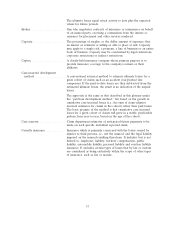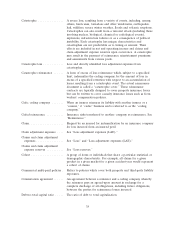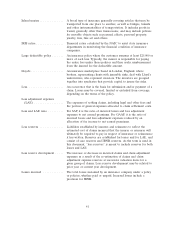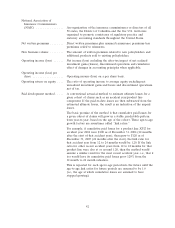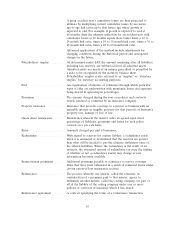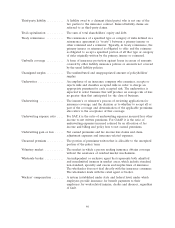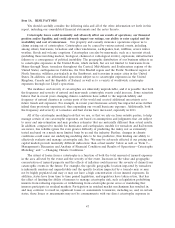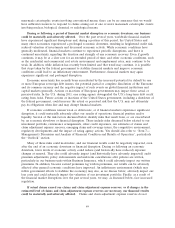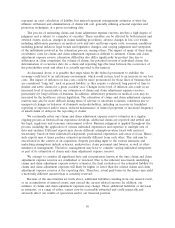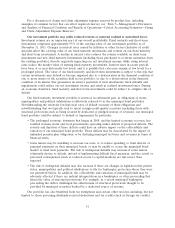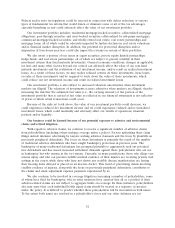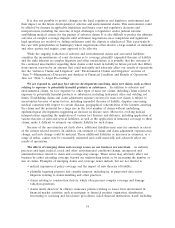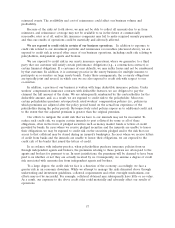Travelers 2011 Annual Report Download - page 59
Download and view the complete annual report
Please find page 59 of the 2011 Travelers annual report below. You can navigate through the pages in the report by either clicking on the pages listed below, or by using the keyword search tool below to find specific information within the annual report.Item 1A. RISK FACTORS
You should carefully consider the following risks and all of the other information set forth in this
report, including our consolidated financial statements and the notes thereto.
Catastrophe losses could materially and adversely affect our results of operations, our financial
position and/or liquidity, and could adversely impact our ratings, our ability to raise capital and the
availability and cost of reinsurance. Our property and casualty insurance operations expose us to
claims arising out of catastrophes. Catastrophes can be caused by various natural events, including,
among others, hurricanes, tornadoes and other windstorms, earthquakes, hail, wildfires, severe winter
weather, floods and volcanic eruptions. Catastrophes can also be man-made, such as a terrorist attack
(including those involving nuclear, biological, chemical or radiological events), explosions, infrastructure
failures or a consequence of political instability. The geographic distribution of our business subjects us
to catastrophe exposures in the United States, which include, but are not limited to: hurricanes from
Maine through Texas; tornadoes throughout the Central, Mid-Atlantic and Southeastern regions of the
United States; earthquakes in California, the New Madrid region and the Pacific Northwest region of
North America; wildfires, particularly in the Southwest; and terrorism in major cities in the United
States. In addition, our international operations subject us to catastrophe exposures in the United
Kingdom, Canada and the Republic of Ireland, as well as to a variety of world-wide catastrophe
exposures through our Lloyd’s operations.
The incidence and severity of catastrophes are inherently unpredictable, and it is possible that both
the frequency and severity of natural and man-made catastrophic events could increase. Some scientists
believe that in recent years changing climate conditions have added to the unpredictability and
frequency of natural disasters in certain parts of the world and created additional uncertainty as to
future trends and exposures. For example, in recent years hurricane activity has impacted areas further
inland than previously experienced, thus expanding our overall hurricane exposure. Additionally, both
the frequency and severity of tornadoes and hail storms have increased, especially in 2011.
All of the catastrophe modeling tools that we use, or that we rely on from outside parties, to help
manage certain of our catastrophe exposures are based on assumptions and judgments that are subject
to error and mis-estimation and may produce estimates that are materially different than actual results.
In addition, compared to models for hurricanes and earthquakes, models for tornadoes and hail storms
are newer, less reliable (given the even greater difficulty of predicting the risks), not as extensively
tested and used on a much more limited basis by us and the industry. Further, changes in climate
conditions could cause our underlying modeling data to be less predictive, thus limiting our ability to
effectively evaluate and manage catastrophe risk. See ‘‘We may be adversely affected if our pricing and
capital models provide materially different indications than actual results’’ below as well as ‘‘Item 7—
Management’s Discussion and Analysis of Financial Condition and Results of Operations—Catastrophe
Modeling’’ and ‘‘—Changing Climate Conditions.’’
The extent of losses from a catastrophe is a function of both the total amount of insured exposure
in the area affected by the event and the severity of the event. Increases in the value and geographic
concentration of insured property and the effects of inflation could increase the severity of claims from
catastrophic events in the future. For example, the specific geographic location impacted by tornadoes
is inherently random and unpredictable and the specific location impacted by a tornado may or may
not be highly populated and may or may not have a high concentration of our insured exposures. In
addition, states have from time to time passed legislation, and regulators have taken action, that has
the effect of limiting the ability of insurers to manage catastrophe risk, such as legislation prohibiting
insurers from reducing exposures or withdrawing from catastrophe-prone areas or mandating that
insurers participate in residual markets. Participation in residual market mechanisms has resulted in,
and may continue to result in, significant losses or assessments to insurers, including us, and, in certain
states, those losses or assessments may not be commensurate with our direct catastrophe exposure in
47


